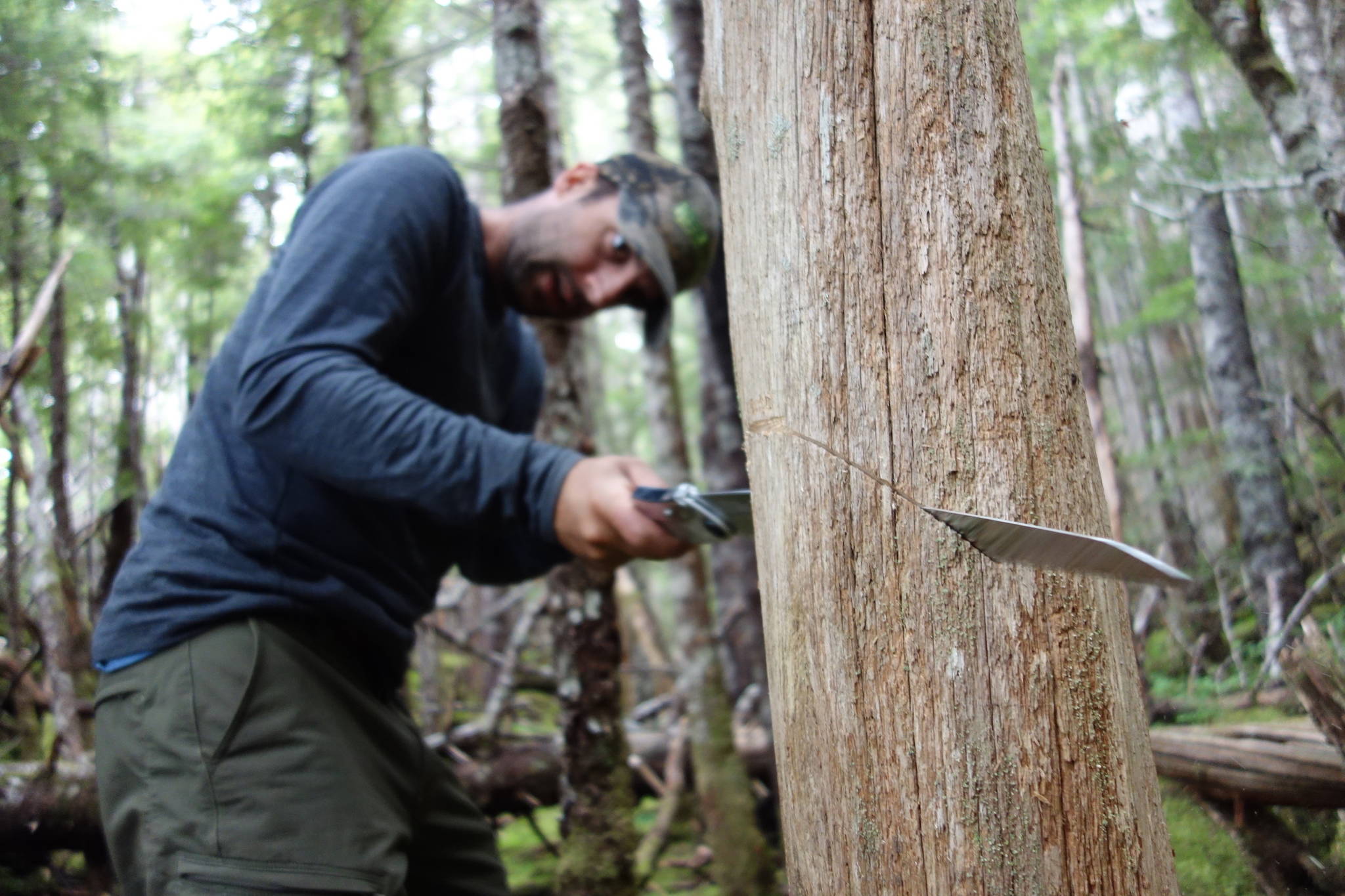A HILLSIDE ABOVE LA PEROUSE GLACIER — Ben Gaglioti slices a foot-long blade through the trunk of a tree that died long before he was born.
As he cuts the solid wood, yellow chips fly. A clean, familiar scent wafts through the air. I think of a cedar drawer in my boyhood home where my dad stored his pipe tobacco.
Here, in a forest a few hundred feet above a shrinking glacier, Gaglioti is felling one of the most enigmatic trees in Alaska: an Alaska yellow cedar.
These trees, which can live longer than 1,000 years, grow on the rainy coast from the Oregon/California border through British Columbia and as far north as Prince William Sound. The giants have in many areas died in large numbers, puzzling scientists who later came up with a non-intuitive theory of what killed them.
Gaglioti, a University of Alaska Fairbanks ecologist, is here to learn more about Alaska yellow cedar. He and I are camped in a nearby ghost forest that La Perouse Glacier ran over in the late 1800s.
Gaglioti is taking down this long-dead tree — 25 feet tall and branchless, greatly resembling a weathered telephone pole — so that he can bring a slice of it back to the university. There, he can look at the tree’s rings in greater detail, and read the story it has to tell.
We trade off the cutting that works us both into a sweat in the moist, cool air. Each stroke is full, ringing the steel blade, as if we are cutting a beam from the lumberyard. And there’s that heavenly, evocative smell, which will later permeate my backpack and my binoculars and my balled-up raincoat as I carry samples back to camp.
Ben lets me finish with the last horizontal strokes. I speed up in an attempt for a clean cut. Soon, a disc of cedar the size of my hand sits atop the stump of the tree.
Gaglioti picks it up. First, he gives it the irresistible sniff, enjoying the perfume that fires certain regions of his brain. Then he looks to the tight ring pattern with a trained eye.
“This one’s old, — it lived for maybe 300 years,” Gaglioti says. “Wonder when they died?”
He refers to a wide pincushion of standing dead cedar stems on the hillsides above La Perouse Glacier and at many other locations in Southeast Alaska.
The skeletal trees are conspicuous in the rainforest, standing as they are like gray spears pointing upward. Unlike other trees, they don’t seem to fall after they die. Gaglioti and his colleagues have found that some cedars have remained pointing to the heavens as long as 400 years after their last leaves have withered and dropped to the forest floor.
Probably because of chemical compounds within the tree like nootkatin that emit the pleasant odor and tint the wood yellow, Alaska yellow cedar endures like no other tree in the state.
In a 1997 paper on the endurance and possible usefulness of dead Alaska yellow-cedar trees, researchers Kent McDonald and Paul Hennon concluded it was good stuff:
“All wood tested from the dead yellow-cedar trees, regardless of the number of years the trees had been dead, appeared to maintain strength with time. Not one of the snags, in any class, had lost enough strength to prevent it from potentially being used.”
Hennon, a forest pathologist with the U.S. Forest Service in Juneau, was among the scientists who came up with a theory for the cause of death of 65 percent of Alaska yellow cedars on more than one-half million acres in Southeast Alaska over the last few decades. Their conclusion: warmer winter temperatures sometimes melt snow cover from the sensitive roots of trees. This takes away the blanket that protects the fine roots system from cold air. When colder weather returns, the roots die after being exposed to lethal temperatures of about 23 degrees Fahrenheit.
With these trees — like the one we just cut right at the boundary of where La Perouse Glacier was at its maximum bulk in about 1900 — Gaglioti wonders if the glacier’s cold breath helped kill these cedars.
He also wonders aloud why we see so many live cedars on an adjacent hillside, many of them quite old.
They do seem to be remarkable organisms. A tree near one of our campsites had a crack at its base through which we could pass the folded saw. Yet the tree was still alive, with just one rope of cambium — the outer bark that transports water and nutrients — snaking up the trunk. A few of its blue-green feathery leaves flagged from the top of what otherwise looked like a snag.
During our two weeks exploring the outer coast area of Glacier Bay National Park and Preserve, Gaglioti collected a few dozen samples of cedar in the form of biscuits and pencil-like cores.
He would export them to Fairbanks for further study on what the Alaska yellow cedar can tell us about climate change past and present. The answers would come in the future, but this much was clear: his luggage smelled better than anyone else’s.
• Since the late 1970s, the University of Alaska Fairbanks’ Geophysical Institute has provided this column free in cooperation with the UAF research community. This year is the institute’s 75th anniversary. Ned Rozell ned.rozell@alaska.edu is a science writer for the Geophysical Institute.

